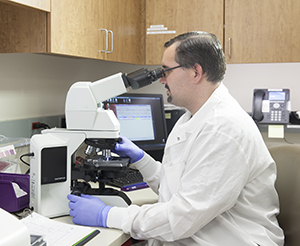When your child has blood in their urine, it's called hematuria. This can be scary to hear. But there are many reasons why hematuria occurs that are not serious. Your doctor thinks a problem in your child’s urinary tract is causing hematuria. One or more tests are needed to figure out the exact cause. Once the cause is found, the problem can be treated or managed if needed.
There are 2 types of hematuria:
-
Gross hematuria. This means that blood can be seen when looking at the urine with the naked eye. The urine may look pinkish, brownish, or bright red.
-
Microscopic hematuria. This means that the urine looks clear, but red blood cells can be seen when the urine is looked at under a microscope.
Both types may mean there is a problem somewhere in the body. But one is not more serious than the other.
What are the possible causes of hematuria?
-
It runs in the family
-
Bladder or kidney infection
-
Certain medicines
-
Vigorous exercise
-
Damage to the urinary tract or catheter use
-
Kidney stones
-
Blockage in the urinary tract
-
Diseases, such as sickle cell anemia, low platelet counts (thrombocytopenia), and impaired blood clotting disorders (coagulopathy)
-
Kidney disease
-
Trauma (such as after falling from a bicycle, a car accident, or blow to the kidneys or abdomen)
-
High calcium levels in the urine (hypercalciuria)
-
Eating an excessive amount of beets (called beeturia) or foods containing food dyes
How is hematuria diagnosed?
Your doctor will ask you questions about your child’s health. A physical exam will also be done to look for problems. One or more of the following tests may be done to find the cause of your child’s hematuria:
-
Urinalysis. This checks the urine for blood, proteins, or other problems. It may be checked for calcium. Urine culture will be done if there are symptoms of a bladder or kidney infection.
-
Blood tests. These are done to look for anemia and infection. Kidney function tests like serum creatinine and blood urea nitrogen are also done to find kidney disease.
-
Kidney and bladder ultrasound. These create images of the kidney and bladder using sound waves. It is done to confirm the presence and location of a kidney stone or if your child has had a recent injury.
-
A KUB (kidney, ureter, bladder) X-ray. This is done to find out if your child has kidney stones or another problem.
-
CT scan. This gives the doctor a more detailed image of the kidney and bladder than a regular X-ray. It's done to confirm the location of a kidney stone or to assess the damage caused by injury.
-
Voiding cystourethrogram. This is a type of X-ray imaging of the bladder and urinary tract. It uses a special type of X-ray called fluoroscopy and water-soluble contrast material. It shows how the bladder and lower urinary tract are working, especially during urination.
-
Cystoscopy. This test looks at and checks for bleeding or other problems inside the urethra, ureter, and bladder. It uses a small flexible scope with a camera at the end.
How is hematuria treated?
Treatment depends on what’s causing the bleeding. Your child’s doctor will discuss the cause of bleeding. They will also talk about the best possible treatment choices.
Featured in


